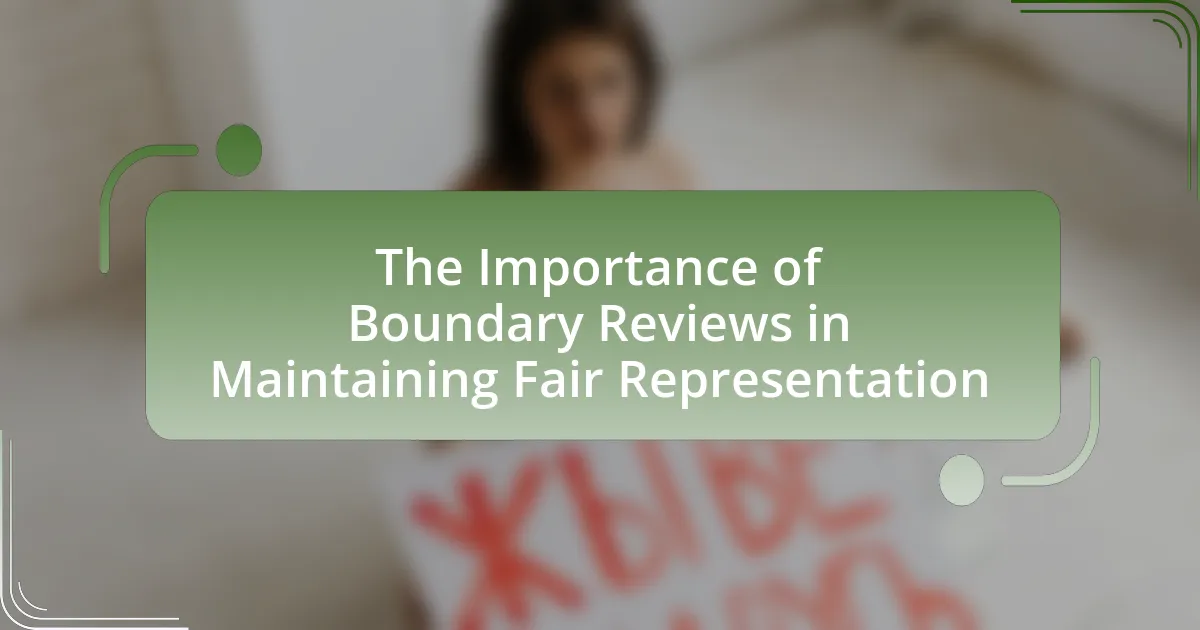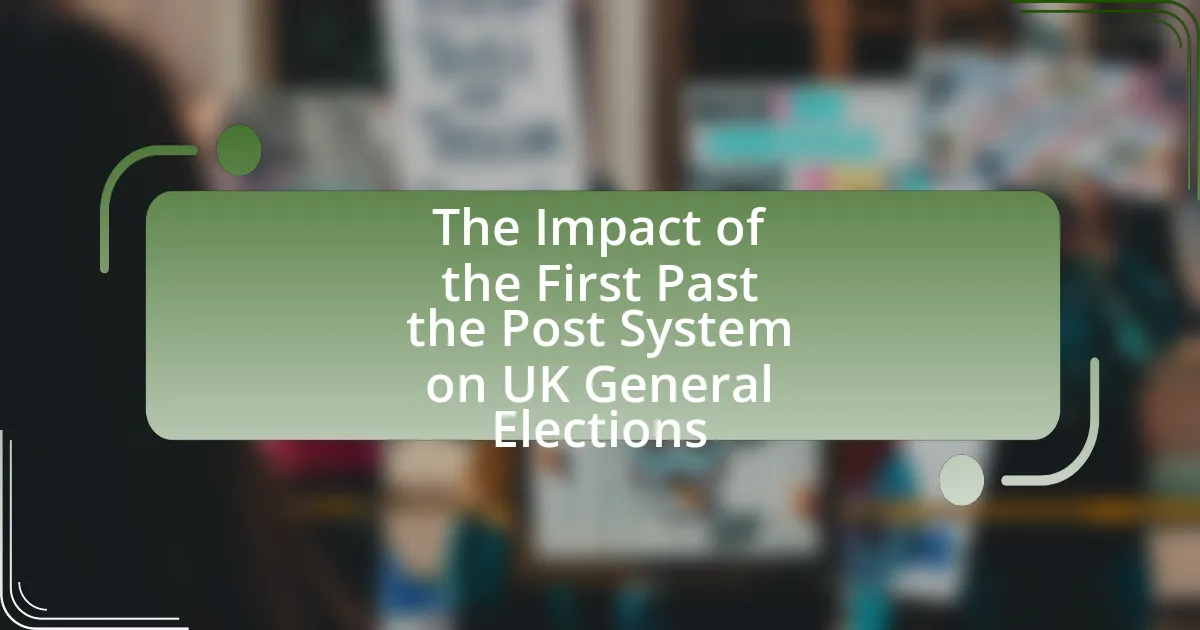Gender representation in UK politics refers to the proportion of men and women in political roles, with women currently holding approximately 34% of seats in the House of Commons as of 2023. This article examines the importance of gender representation, its impact on policy-making and public perception, and the current statistics reflecting progress and challenges in achieving gender equality in political representation. It highlights systemic barriers, societal attitudes, and the role of political parties in influencing gender diversity, while also discussing initiatives aimed at promoting female participation and the successes achieved in recent years. Additionally, the article addresses the intersectional factors affecting representation and suggests practical steps for further enhancing gender diversity in UK politics.
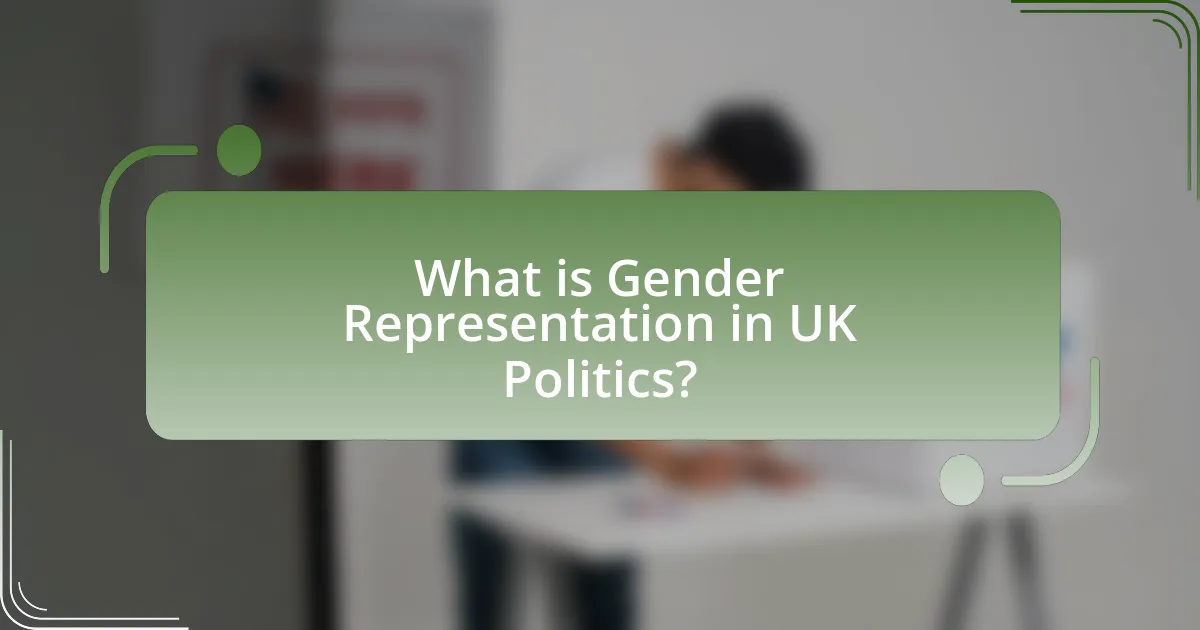
What is Gender Representation in UK Politics?
Gender representation in UK politics refers to the proportion of men and women in political positions, including Parliament, local councils, and other governmental roles. As of 2023, women hold approximately 34% of the seats in the House of Commons, reflecting a gradual increase from 29% in 2015. This progress is supported by initiatives such as the Labour Party’s all-women shortlists and the Conservative Party’s efforts to promote female candidates, which have contributed to a more balanced representation. Despite these advancements, challenges remain, including systemic barriers and societal attitudes that continue to hinder equal representation.
Why is gender representation important in politics?
Gender representation is important in politics because it ensures that diverse perspectives and experiences are included in decision-making processes. When women and other marginalized genders are represented, policies are more likely to address the needs of the entire population rather than just a select group. Research shows that countries with higher levels of gender representation in political offices tend to have more comprehensive social policies, improved economic outcomes, and greater overall governance effectiveness. For instance, a study by the Inter-Parliamentary Union found that increasing women’s representation in parliament can lead to enhanced legislative attention to issues such as health, education, and family welfare, which are often prioritized by women.
What impact does gender representation have on policy-making?
Gender representation significantly influences policy-making by ensuring diverse perspectives are included in the legislative process. Research indicates that increased female representation leads to the prioritization of issues such as healthcare, education, and family policies, which are often overlooked in male-dominated environments. For instance, a study by the Inter-Parliamentary Union found that countries with higher percentages of women in parliament are more likely to pass laws promoting gender equality and social welfare. This correlation underscores the importance of gender diversity in shaping policies that reflect the needs of the entire population.
How does gender representation influence public perception of politics?
Gender representation significantly influences public perception of politics by shaping the way individuals view political efficacy and inclusivity. When women are visibly represented in political roles, it enhances the perception that political institutions are more accessible and responsive to diverse populations. Research indicates that increased female representation correlates with higher public trust in government and greater political engagement among women. For instance, a study by the Inter-Parliamentary Union found that countries with higher percentages of women in parliament tend to have more progressive policies on issues such as health and education, which positively affects public perception of political effectiveness. This demonstrates that gender representation not only impacts the composition of political bodies but also influences how the public perceives the legitimacy and functionality of those institutions.
What are the current statistics on gender representation in UK politics?
As of October 2023, women hold 34% of the seats in the UK Parliament, reflecting a gradual increase in gender representation. In the House of Commons, there are currently 225 female MPs out of 650 total members. This statistic indicates a significant rise from 29% in 2017. Additionally, in the House of Lords, women represent 27% of the members, which shows a slight increase from previous years. These figures highlight ongoing efforts to improve gender balance in UK politics, although challenges remain in achieving equal representation.
How do these statistics compare to previous years?
The statistics on gender representation in UK politics show a gradual increase in female representation compared to previous years. For instance, as of 2023, women hold 34% of seats in the House of Commons, up from 32% in 2019 and 29% in 2015. This upward trend indicates a positive shift towards gender equality in political representation, supported by initiatives aimed at encouraging female candidates and addressing systemic barriers.
What are the gender ratios in different political parties?
The gender ratios in different political parties in the UK vary significantly. For instance, as of the latest data, the Labour Party has approximately 52% female representation among its Members of Parliament (MPs), while the Conservative Party has around 34%. The Liberal Democrats report about 47% female MPs, and the Scottish National Party (SNP) has around 45%. These figures highlight the disparities in gender representation across political parties, with Labour leading in female representation. The statistics are sourced from the UK Parliament’s official records and various political analyses conducted in 2023.
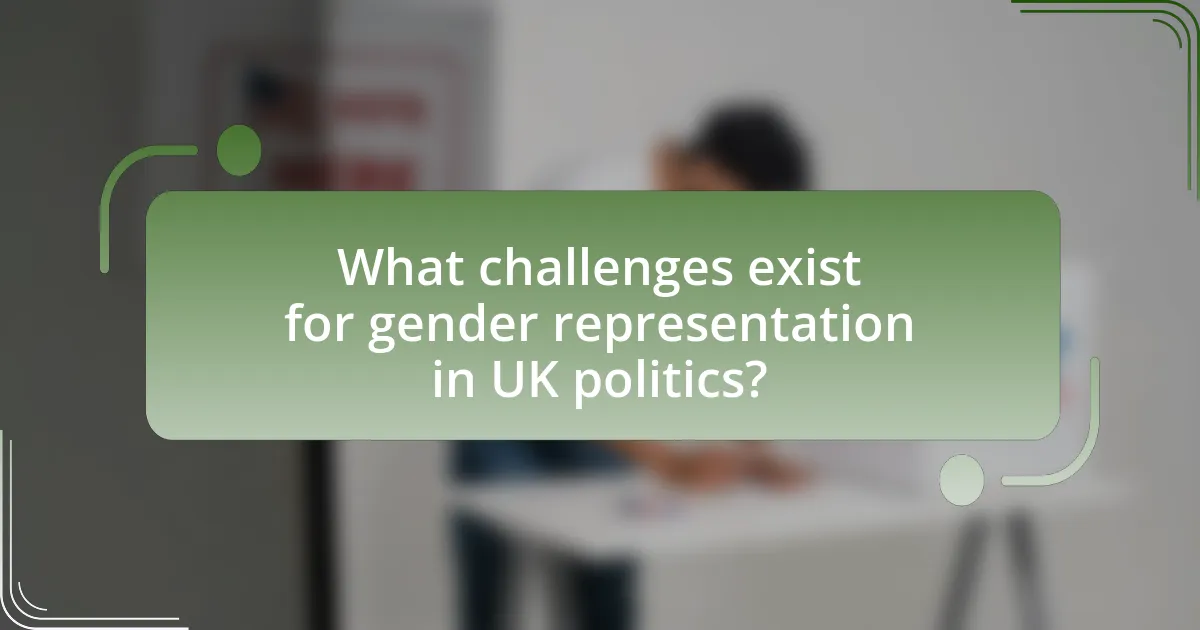
What challenges exist for gender representation in UK politics?
Challenges for gender representation in UK politics include systemic barriers, cultural biases, and a lack of support for women candidates. Systemic barriers manifest in the form of party selection processes that often favor male candidates, limiting women’s opportunities to secure nominations. Cultural biases persist in societal perceptions of leadership, where traditional gender roles can undermine women’s authority and capabilities. Additionally, the lack of mentorship and funding for women candidates further exacerbates the issue, as evidenced by the fact that women make up only 34% of Members of Parliament as of 2023, highlighting the ongoing underrepresentation in political positions.
What barriers do women face in entering politics?
Women face several barriers in entering politics, including systemic discrimination, lack of access to networks, and societal expectations. Systemic discrimination manifests in political institutions that often favor male candidates, resulting in fewer opportunities for women to be nominated or elected. Additionally, women frequently encounter challenges in accessing influential political networks that are predominantly male, which limits their ability to gain support and resources necessary for political campaigns. Societal expectations also play a significant role, as traditional gender roles can discourage women from pursuing political careers or lead to negative perceptions when they do. According to a report by the House of Commons Women and Equalities Committee, only 34% of MPs are women, highlighting the ongoing underrepresentation and the barriers that persist in the political landscape.
How do societal attitudes affect women’s political participation?
Societal attitudes significantly influence women’s political participation by shaping perceptions of gender roles and expectations. Research indicates that traditional views often discourage women from pursuing political careers, as seen in the UK where women are underrepresented in leadership positions. For instance, a study by the House of Commons Library in 2021 highlighted that only 34% of Members of Parliament were women, reflecting societal biases that prioritize male leadership. Additionally, negative stereotypes about women’s capabilities in politics can lead to lower self-confidence among potential female candidates, further hindering their participation. Thus, societal attitudes create barriers that limit women’s engagement in political processes.
What role does party structure play in hindering gender representation?
Party structure significantly hinders gender representation by perpetuating hierarchical systems that favor established male leadership. Political parties often have internal processes and cultures that prioritize the interests and perspectives of male members, leading to a lack of support for female candidates. For instance, research by the Electoral Commission in 2019 indicated that women made up only 34% of candidates for the UK Parliament, reflecting systemic barriers within party selection processes. Additionally, party structures may lack mechanisms for promoting gender equality, such as quotas or targeted recruitment strategies, further entrenching male dominance in political roles.
How do intersectional factors impact gender representation?
Intersectional factors significantly impact gender representation by highlighting how overlapping identities, such as race, class, and sexual orientation, influence individuals’ experiences and opportunities in political spaces. For instance, women of color often face compounded barriers compared to their white counterparts, resulting in underrepresentation in political roles. According to the 2021 report by the House of Commons Women and Equalities Committee, only 3% of MPs in the UK are women of color, illustrating the stark disparities in representation. This intersectionality reveals that gender alone does not determine political representation; rather, it interacts with other social categories to shape individuals’ access to power and influence.
What challenges do women from diverse backgrounds encounter in politics?
Women from diverse backgrounds encounter several challenges in politics, including systemic barriers, lack of representation, and intersectional discrimination. Systemic barriers manifest as limited access to political networks and resources, which hinders their ability to campaign effectively. According to a 2020 report by the House of Commons Women and Equalities Committee, women from ethnic minorities are significantly underrepresented in UK politics, comprising only 6.3% of Members of Parliament. Additionally, intersectional discrimination affects women based on race, ethnicity, and socioeconomic status, leading to unique obstacles that differ from those faced by their white counterparts. This discrimination can result in negative stereotypes and biases that undermine their credibility and authority in political spaces.
How does socioeconomic status influence political representation?
Socioeconomic status significantly influences political representation by affecting individuals’ access to political resources and opportunities. Individuals from higher socioeconomic backgrounds often have greater access to education, networks, and financial resources, which can facilitate their entry into politics and increase their chances of being elected. For example, a study by the Joseph Rowntree Foundation found that candidates from affluent backgrounds are more likely to secure party nominations and win elections, highlighting the disparity in representation based on socioeconomic factors. Conversely, those from lower socioeconomic backgrounds may face barriers such as limited financial support and fewer connections, leading to underrepresentation in political offices.
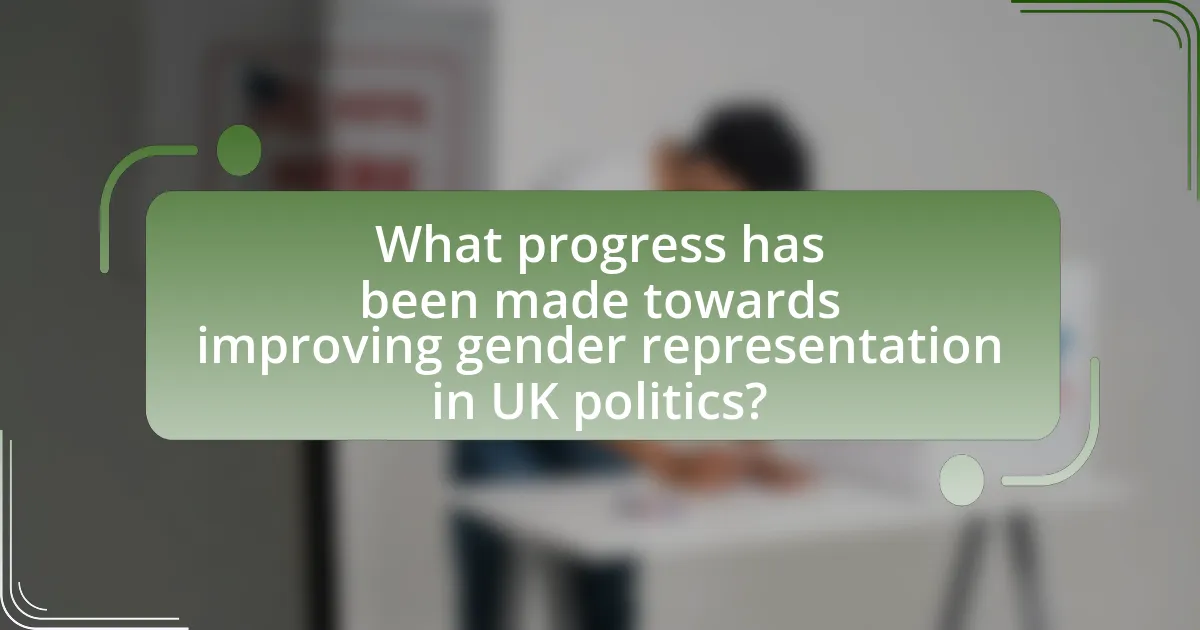
What progress has been made towards improving gender representation in UK politics?
Progress towards improving gender representation in UK politics includes an increase in the number of women elected to Parliament, with women now making up approximately 34% of Members of Parliament as of the 2019 general election, up from 29% in 2017. Additionally, the Labour Party has implemented all-women shortlists in certain constituencies, which has contributed to a higher proportion of female candidates. The introduction of initiatives like the Women in Politics campaign has also aimed to encourage female participation in political roles. Furthermore, the UK government has set targets for gender balance in public appointments, aiming for at least 50% of new appointments to be women. These measures collectively reflect a commitment to enhancing gender representation in political spheres.
What initiatives have been implemented to promote gender equality in politics?
Initiatives to promote gender equality in politics include the implementation of gender quotas, training programs for women candidates, and support networks. Gender quotas, such as those established by the Labour Party in the UK, require a certain percentage of candidates to be women, significantly increasing female representation in elected positions. Additionally, organizations like the Fawcett Society provide training and resources to empower women to run for office, while initiatives like the Women’s Equality Party focus on advocating for policy changes that support gender parity. These measures have been shown to enhance women’s participation in political processes, contributing to a more balanced representation in governance.
How effective have these initiatives been in increasing female representation?
The initiatives aimed at increasing female representation in UK politics have been moderately effective, resulting in a gradual rise in the number of women in parliamentary positions. For instance, the proportion of female Members of Parliament (MPs) increased from 22% in 2010 to 34% in 2019, reflecting the impact of measures such as all-women shortlists and targeted training programs. Additionally, the introduction of the Gender Equality Duty in 2006 mandated public bodies to promote gender equality, further contributing to this upward trend. These statistics demonstrate that while challenges remain, the initiatives have positively influenced female representation in UK politics.
What role do mentorship and training programs play in supporting women in politics?
Mentorship and training programs play a crucial role in supporting women in politics by providing essential skills, networking opportunities, and confidence-building experiences. These programs equip women with the knowledge and tools necessary to navigate the political landscape, addressing barriers such as gender bias and lack of representation. For instance, research by the Fawcett Society highlights that women who participate in mentorship initiatives are more likely to pursue political roles and succeed in elections, demonstrating the effectiveness of these programs in fostering female leadership. Additionally, training programs often focus on public speaking, campaign strategies, and policy development, which are vital for women to effectively engage in political discourse and decision-making processes.
What successes can be highlighted in recent years?
Recent years have seen significant successes in gender representation within UK politics, notably the increase in the number of women elected to Parliament. As of the 2019 General Election, women constituted 34% of Members of Parliament, a record high, reflecting a steady rise from 29% in 2017. This increase is supported by initiatives such as the Labour Party’s commitment to all-women shortlists and the Conservative Party’s efforts to promote female candidates, which have contributed to a more diverse political landscape. Additionally, the appointment of women to key leadership positions, including the first female Speaker of the House of Commons, has further underscored this progress.
Which political parties have made significant strides in gender representation?
The Labour Party and the Liberal Democrats have made significant strides in gender representation within UK politics. The Labour Party has implemented all-women shortlists, resulting in a substantial increase in female MPs, with women making up over 50% of its parliamentary candidates in recent elections. The Liberal Democrats have also focused on gender equality, achieving a near 50% representation of women in their parliamentary candidates in the 2019 general election. These efforts reflect a broader commitment to enhancing gender diversity in political representation.
How have female politicians influenced legislative changes?
Female politicians have significantly influenced legislative changes by advocating for policies that address gender equality and social justice. For instance, the introduction of the Equality Act 2010 in the UK was largely driven by female lawmakers who emphasized the need for comprehensive anti-discrimination laws. Additionally, women in Parliament have championed issues such as domestic violence, leading to the establishment of the Domestic Violence Act 2004, which was influenced by female MPs’ persistent advocacy. Their presence in legislative bodies has resulted in a more inclusive approach to policymaking, ensuring that women’s perspectives and needs are represented in laws and regulations.
What practical steps can be taken to further enhance gender representation in UK politics?
To enhance gender representation in UK politics, implementing mandatory gender quotas for political party candidates is essential. Research indicates that countries with gender quotas, such as Norway, have seen significant increases in female political representation, with women holding 40% of parliamentary seats. Additionally, providing targeted training and mentorship programs for women aspiring to enter politics can help build confidence and skills necessary for leadership roles. Evidence from the UK’s Women’s Equality Party shows that such initiatives can effectively prepare women for candidacy. Furthermore, increasing public awareness campaigns about the importance of gender diversity in political decision-making can shift societal attitudes and encourage more women to participate in politics.
What strategies can political parties adopt to improve gender diversity?
Political parties can adopt strategies such as implementing gender quotas, enhancing mentorship programs, and promoting flexible work arrangements to improve gender diversity. Gender quotas, which have been successfully used in countries like Sweden, mandate a certain percentage of candidates to be women, thereby increasing female representation. Mentorship programs can support women in navigating political careers, as evidenced by initiatives like the Women in Politics program in the UK, which has shown positive outcomes in empowering female candidates. Additionally, promoting flexible work arrangements can help accommodate the diverse needs of women, making political roles more accessible. These strategies collectively contribute to a more inclusive political landscape.
How can grassroots movements contribute to better representation?
Grassroots movements can contribute to better representation by mobilizing communities to advocate for inclusive policies and amplify marginalized voices. These movements often engage local populations, fostering awareness and participation in political processes, which can lead to increased representation of underrepresented groups, including women and minorities. For instance, the Women’s March in 2017 galvanized millions globally, highlighting issues of gender inequality and influencing political discourse, which resulted in a record number of women elected to office in subsequent elections. This demonstrates that grassroots efforts can effectively challenge systemic barriers and promote diverse representation in politics.



